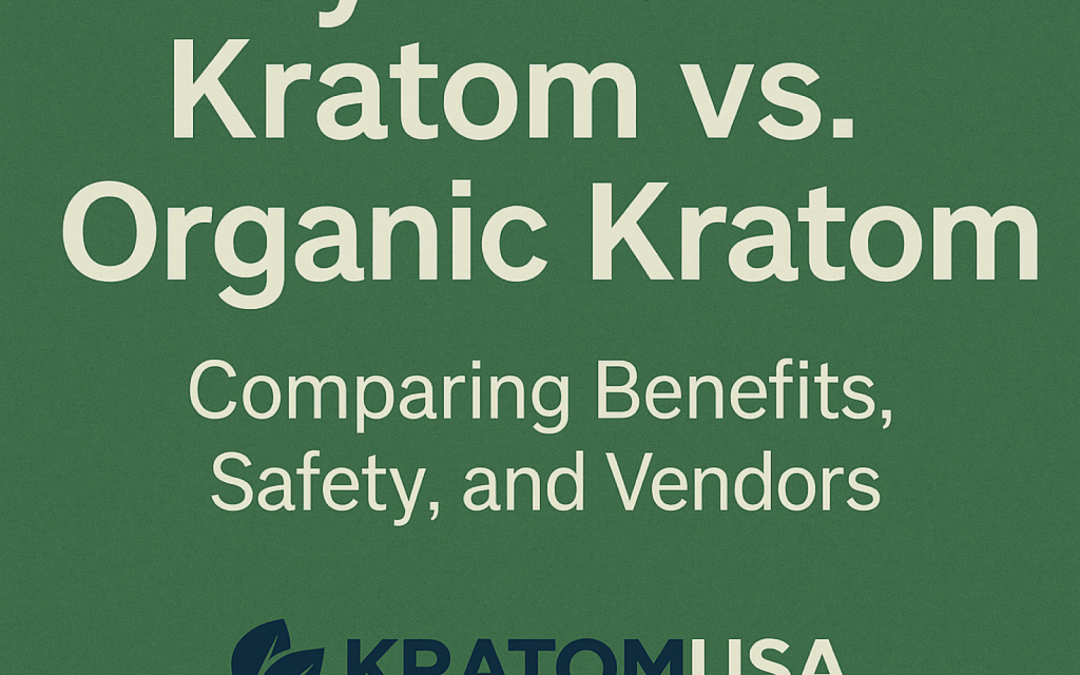
by KratomUSA | Aug 19, 2025 | Kratom
🌱 Understanding the Risks, Benefits, and Why Natural Kratom Is the Safer Choice
Kratom has gained a lot of attention in recent years—both for its natural benefits and for controversy surrounding synthetic alternatives. While organic kratom has been used safely for centuries in Southeast Asia, synthetic kratom products have introduced new concerns about safety, quality, and efficacy. This article dives into the differences between synthetic and natural kratom, highlights the benefits of full-spectrum natural kratom, and explains why sourcing your kratom from a trusted vendor like Kratom USA matters more than ever.
🔑 Key Points
-
Organic kratom is derived directly from the kratom leaf and contains a full spectrum of natural alkaloids
-
Synthetic kratom is lab-created and may not offer the same balanced effects or safety profile
-
Natural kratom has centuries of safe, documented use
-
Buying from a reputable vendor like Kratom USA ensures purity and consistency
-
Synthetic alternatives may pose unknown risks and lack regulatory oversight
🌿 What Is Organic Kratom?
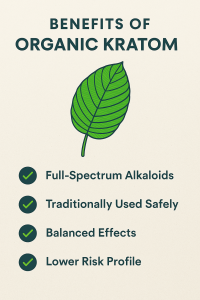 Organic kratom is the dried, ground leaf of the Mitragyna speciosa tree, which grows in Southeast Asia. Traditionally brewed into tea or chewed for energy and focus, kratom leaves contain dozens of naturally occurring alkaloids, such as mitragynine and 7-hydroxymitragynine, that work synergistically to provide balanced effects.
Organic kratom is the dried, ground leaf of the Mitragyna speciosa tree, which grows in Southeast Asia. Traditionally brewed into tea or chewed for energy and focus, kratom leaves contain dozens of naturally occurring alkaloids, such as mitragynine and 7-hydroxymitragynine, that work synergistically to provide balanced effects.
Natural kratom is known for its:
⚗️ What Is Synthetic Kratom?
Synthetic kratom refers to lab-made substances designed to mimic the effects of natural kratom alkaloids—most often 7-hydroxymitragynine or mitragynine. These compounds may be produced artificially or isolated at concentrations far higher than those found in nature.
Common concerns with synthetic kratom include:
Synthetic versions may bypass the natural “checks and balances” that come from kratom’s full-spectrum profile, raising safety concerns even among seasoned users.
✅ Benefits of Choosing Organic Kratom
Organic kratom offers a safe, time-tested experience supported by traditional use and modern research. Benefits include:
-
🌿 Full-spectrum alkaloids – Natural synergy promotes smoother effects
-
⏳ Centuries of safe use – Documented in cultures across Southeast Asia
-
💧 Minimally processed – No artificial additives or lab-created compounds
-
🧘 Balanced effects – Less risk of overstimulation or adverse reactions
🗣️ “I’ve used natural kratom for years and I wouldn’t touch the synthetic stuff. Kratom USA’s quality has always been consistent and clean.” – Laura B., Verified Customer
🧪 Why Synthetic Kratom May Pose Risks
The appeal of stronger, faster effects often draws people to synthetic kratom—but the trade-offs are rarely worth it.
Key risks include:
-
❌ Lack of traditional history – Synthetic compounds haven’t stood the test of time
-
⚠️ Overconcentration of isolated alkaloids – Increases risk of dependency and side effects
-
❓ Unregulated production – No oversight or quality testing in many synthetic kratom sources
🛡️ Why Vendor Transparency Matters
Where you buy your kratom is just as important as what kind you choose. The kratom industry has seen a flood of low-quality or mislabeled products, particularly with synthetic kratom blends.
A trusted vendor should offer:
-
📜 Third-party lab testing
-
🌎 Sustainably sourced leaves
-
🚫 No synthetics or adulterants
-
📦 Transparent packaging and labeling
🏆 Why Kratom USA Stands Out
KratomUSA.com has been in the kratom industry for nearly 20 years, making it one of the oldest and most respected kratom vendors in the U.S.
What sets them apart:
-
✅ Only sells 100% natural, organic kratom
-
🧪 Every batch is lab tested for purity
-
🇺🇸 U.S.-based operations with strict quality controls
-
🌿 Offers a wide range of strains and formats (powder, capsules, tinctures)
🗣️ “I trust Kratom USA because they’ve been around forever, and their kratom has never let me down.” – Mike T., longtime customer
📌 Key Points Recap
-
Organic kratom is full-spectrum, naturally balanced, and time-tested
-
Synthetic kratom is lab-created, often unregulated, and can be risky
-
Trustworthy vendors like Kratom USA offer only natural kratom, backed by lab testing
-
Always read labels and avoid products that contain “enhanced,” “extract,” or synthetic ingredients unless fully transparent
❓ Frequently Asked Questions
🤔 Is synthetic kratom legal?
It depends. Some synthetic alkaloids may be legal in certain states but fall under scrutiny due to their similarity to controlled substances.
🌿 Is organic kratom safer than synthetic?
Yes. Organic kratom has a long record of traditional use, while synthetic versions are newer and carry more unknowns.
🛍️ Where can I buy organic kratom online?
KratomUSA.com is a trusted vendor offering high-quality, lab-tested, all-natural kratom products for nearly 20 years.
📉 What are the dangers of synthetic kratom?
Synthetic kratom may lack alkaloid balance, leading to exaggerated effects, higher risk of dependency, and unregulated manufacturing.
As kratom continues to grow in popularity, it’s important to stay informed about what you’re putting into your body. Choosing natural, full-spectrum kratom from a trusted source like Kratom USA ensures you’re getting a product that honors tradition, prioritizes safety, and supports well-being. In a world full of shortcuts, nature still does it best.
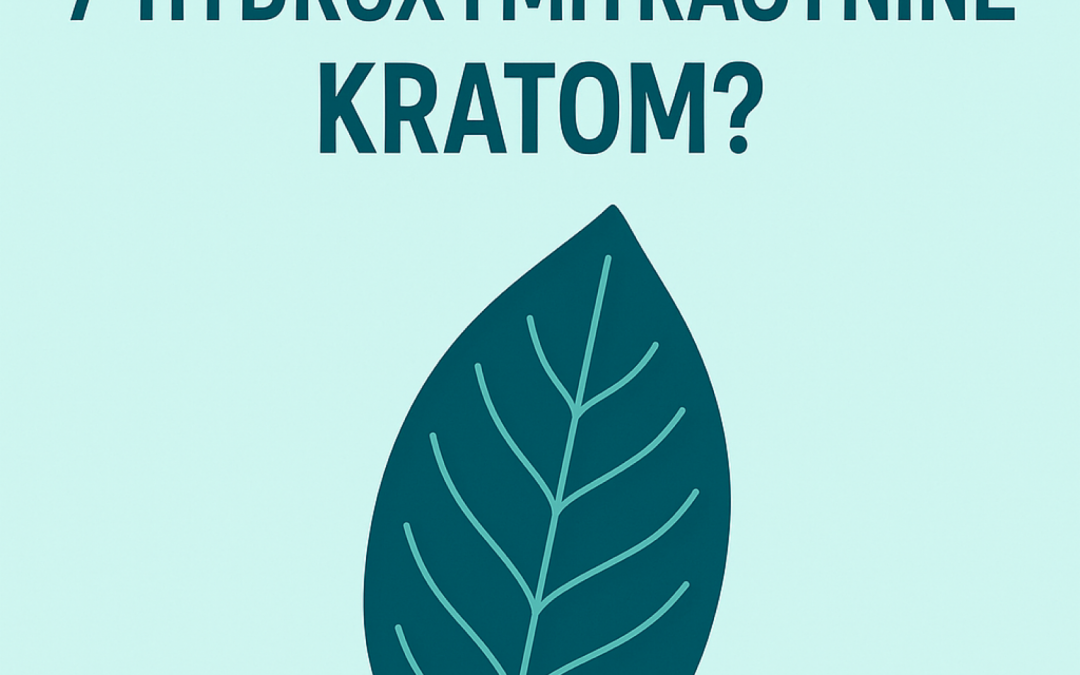
by KratomUSA | Aug 13, 2025 | Kratom
🔬 Understanding the Role of Kratom’s Most Potent Alkaloid and Why Natural Is Better
Is 7-Hydroxymitragynine Kratom? The short answer is no—natural kratom and the alkaloid 7-hydroxymitragynine are not the same. While 7-hydroxymitragynine is one of over 40 known alkaloids found in kratom, it exists only in very small amounts in the raw leaf. Kratom, in its natural full-spectrum form, has been used safely for hundreds of years throughout Southeast Asia for its energizing and mood-balancing effects. Unlike isolated alkaloids that may carry a higher risk of side effects or regulatory scrutiny, traditional kratom offers a complex and balanced profile that works in harmony with the body. In this article, we’ll explore what 7-hydroxymitragynine is, why it’s often misunderstood, and why full-spectrum kratom remains the preferred option for both safety and effectiveness.
🔑 Key Points
-
🧬 7-Hydroxymitragynine is not kratom itself — it’s one of over 40 alkaloids in the plant.
-
💥 It’s powerful but concentrated, and may produce harsher effects when isolated.
-
🌱 Natural, full-spectrum kratom offers a synergistic blend of alkaloids, promoting balance and reducing risk.
-
🏺 Kratom has been used safely for centuries in its raw, unadulterated form by indigenous populations.
-
⚖️ Modern extracts that isolate 7‑OH are under scrutiny and may not reflect kratom’s traditional safety profile.
🌿 What Is 7-Hydroxymitragynine?
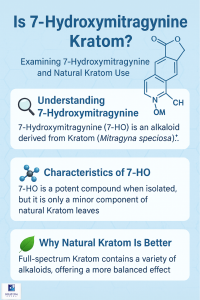 7‑Hydroxymitragynine (often shortened to 7‑OH) is a minor yet highly potent alkaloid found naturally in the leaves of the Mitragyna speciosa tree, commonly known as kratom. It is present in trace amounts, usually under 0.05% of the leaf’s alkaloid content.
7‑Hydroxymitragynine (often shortened to 7‑OH) is a minor yet highly potent alkaloid found naturally in the leaves of the Mitragyna speciosa tree, commonly known as kratom. It is present in trace amounts, usually under 0.05% of the leaf’s alkaloid content.
What makes 7‑OH notable is that, while it’s naturally occurring, it’s also produced inside the human body after ingestion of mitragynine—the most abundant alkaloid in kratom. Through hepatic (liver) metabolism, mitragynine is converted to 7‑OH, which contributes heavily to kratom’s analgesic and sedative effects.
This dual origin—both as a natural trace alkaloid and as a metabolite of mitragynine—has caused confusion. Some believe 7‑OH is kratom, but that’s inaccurate. It’s part of a much broader and complex alkaloid profile found in natural kratom.
🔬 How Potent Is 7‑Hydroxymitragynine?
7‑OH is an extremely powerful mu-opioid receptor agonist—far more potent than mitragynine and even morphine in some lab settings. A 2019 study published in the National Library of Medicine found that:
-
📈 7‑OH is approximately 10–13 times more potent than morphine
-
🧪 It binds more strongly and rapidly to opioid receptors
-
⚠️ It has a higher potential for respiratory depression, dependency, and rapid tolerance buildup when used in isolation
In traditional kratom, the tiny amount of 7‑OH is balanced by other alkaloids such as speciogynine, paynantheine, and speciociliatine, which help buffer and complement its effects.
When 7‑OH is isolated and concentrated, it may produce much stronger effects—similar to opioids. This distinction is crucial when discussing safety, tolerance, and legal classification.
⚖️ Isolates vs. Nature: Why Full-Spectrum Kratom Is Safer 🌿
One of the most important distinctions kratom experts make is between full-spectrum kratom (as nature intended) and single-alkaloid isolates (often lab-extracted).
✅ Benefits of Full-Spectrum Kratom:
-
🧪 Over 40+ Alkaloids work together to provide a balanced, nuanced experience
-
🔄 The entourage effect allows milder, longer-lasting relief
-
🛡️ Lower risk of side effects, especially tolerance, withdrawal, and overstimulation
-
🧘 Traditional use shows long-term safety: communities in Indonesia, Thailand, and Malaysia have used kratom as an herbal remedy for generations—chewing the leaves or making tea, not isolating alkaloids.
🚫 Risks of Isolated 7‑Hydroxymitragynine:
-
💥 Rapid onset, short duration
-
⚠️ High risk of tolerance and dependency
-
🧩 Lacks the modulatory effects of other kratom alkaloids
-
🚨 Often associated with unregulated products sold in gas stations with little quality control
🏺 Traditional Use vs. Modern Extracts
Kratom has been used for centuries in Southeast Asia by farmers, laborers, and healers who prized its mild stimulant and analgesic properties. When used in its natural form—fresh or dried leaves—users typically experienced:
-
🌞 Increased stamina and alertness in low doses
-
🌙 Relaxation and relief from pain in higher doses
-
💧 Little to no withdrawal symptoms after long-term use
In contrast, some modern kratom extracts often isolate or boost 7‑OH far beyond its natural levels, which fundamentally changes the pharmacological experience. These products don’t resemble the kratom that has a cultural history of safe use.
🗣️ What Real Users Say
“I used a 7‑OH extract thinking it was just stronger kratom. But the effects were way different—too intense and addictive. Natural kratom powder feels smoother, easier to control, and more trustworthy.”
— Jesse W., Verified Reviewer
“I’ve been using plain leaf kratom for 5 years with no major issues. The one time I tried a vape-store extract with 7‑OH, it gave me a scary opioid buzz I wasn’t prepared for. Never again.”
— Brianna R., Kratom Advocate
❓ Frequently Asked Questions (FAQ)
🤔 Is 7‑Hydroxymitragynine the same as kratom?
No. Kratom is the whole plant, which contains dozens of alkaloids. 7‑OH is just one of them—and a very potent one.
🧬 Is 7‑OH natural or synthetic?
It is both naturally present in small amounts in kratom and formed in your body when you ingest mitragynine.
⚠️ Is 7‑OH safe to use?
When it’s present in trace, natural amounts, it contributes to kratom’s traditional effects. But in concentrated, isolated form, it may carry opioid-like risks.
🌿 Is full-spectrum kratom better?
Yes. Full-spectrum kratom is better studied, better balanced, and has a long history of safe use—unlike isolated 7‑OH.
🏛️ Is 7‑OH legal?
The FDA and DEA have pushed for Schedule I classification of 7‑OH due to its opioid activity—separate from whole-leaf kratom, which remains legal in many areas. But nothing has been federally legislated to date.
✅ Final Thoughts: Stick With Nature
While 7‑hydroxymitragynine plays a powerful role in kratom’s effects, it is not kratom itself. It’s one component in a symphony of alkaloids that nature designed to work together—not in isolation. If you’re seeking the benefits kratom can offer, choose full-spectrum products from trusted sources and avoid extracts that artificially boost 7‑OH to risky levels.
Centuries of traditional use support the safety of natural kratom. Isolated 7‑OH does not share that legacy.
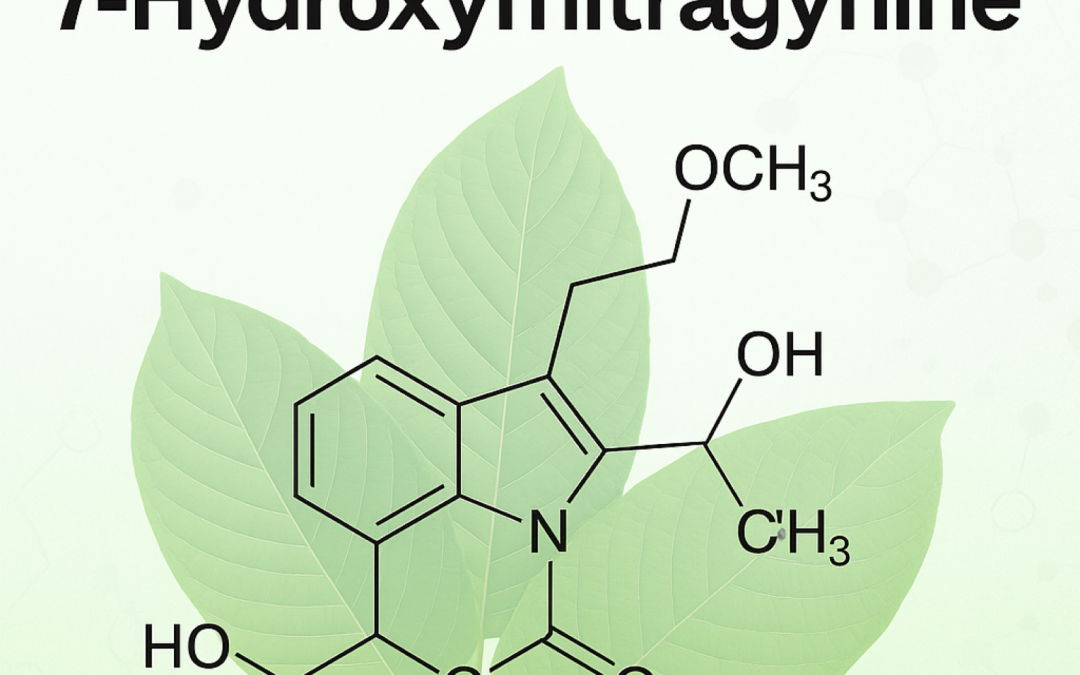
by KratomUSA | Aug 12, 2025 | Kratom
🌱 Explore the Chemical Nature, Effects, and Regulatory Concerns Surrounding 7-Hydroxymitragynine
Kratom has gained increasing attention for its unique alkaloids and potential effects, but among these compounds, 7-Hydroxymitragynine stands out due to its powerful impact on the body. So what is 7-Hydroxymitragynine?
Found naturally in the kratom plant in small amounts, this alkaloid is known for its potent opioid-like effects, which have sparked both interest and concern within scientific, medical, and regulatory communities. In this article, we’ll explore what 7-Hydroxymitragynine is, its effects, health considerations, and why many experts recommend using full-spectrum kratom products instead of isolated extracts for a safer and more balanced experience.
🔑 Key Points
-
Chemical Nature: 7-Hydroxymitragynine (7-OH) is a terpenoid indole alkaloid found in the kratom plant (Mitragyna speciosa).
-
Potency: It is significantly more potent than mitragynine, the primary alkaloid in kratom, and has opioid-like effects.
-
Regulatory Concerns: Due to its potency and potential for abuse, the FDA has recommended classifying 7-OH as a Schedule I controlled substance.
-
Legal Status: While kratom remains legal in many areas, 7-OH is increasingly under scrutiny and facing regulatory actions.
🌿 What Is 7-Hydroxymitragynine?
7-Hydroxymitragynine is a naturally occurring alkaloid in the kratom plant. It is produced as an active metabolite of mitragynine, the primary alkaloid in kratom, through hepatic oxidation. While present in trace amounts in the raw plant, modern extraction techniques have enabled the production of concentrated 7-OH products.
⚖️ Potency and Effects
7-Hydroxymitragynine exhibits a significantly higher binding affinity to μ-opioid receptors compared to mitragynine, making it substantially more potent. This increased potency contributes to its pronounced analgesic and sedative effects.
🧪 Health Implications
Due to its opioid-like properties, 7-OH carries a risk of dependence and withdrawal symptoms. The U.S. Food and Drug Administration (FDA) has issued warning letters to companies marketing products containing 7-OH, highlighting concerns.
📉 Regulatory Actions
In July 2025, the FDA recommended classifying 7-Hydroxymitragynine as a Schedule I controlled substance, indicating high potential for abuse and no accepted medical use.
🌿 Why Choose Full-Spectrum Kratom Over Isolated 7-Hydroxymitragynine?
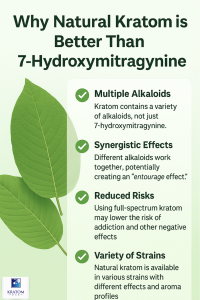 While 7-hydroxymitragynine (7-OH) is a highly potent alkaloid in kratom, many experts and users advocate for using full-spectrum kratom products instead of isolated compounds. Full-spectrum kratom contains a diverse profile of alkaloids—including mitragynine, speciociliatine, paynantheine, and others—that work synergistically to create what is often referred to as the “entourage effect.”
While 7-hydroxymitragynine (7-OH) is a highly potent alkaloid in kratom, many experts and users advocate for using full-spectrum kratom products instead of isolated compounds. Full-spectrum kratom contains a diverse profile of alkaloids—including mitragynine, speciociliatine, paynantheine, and others—that work synergistically to create what is often referred to as the “entourage effect.”
This synergy can provide a more balanced and nuanced experience compared to isolated 7-OH, which may produce stronger but less well-rounded effects. Full-spectrum kratom tends to offer a combination of stimulating, relaxing, and mood-enhancing properties, reducing the likelihood of intense side effects such as rapid tolerance development or withdrawal symptoms often associated with high doses of single alkaloids.
Moreover, full-spectrum kratom is typically considered safer and better suited for long-term use due to its natural composition. It allows the body to benefit from the complex interaction of multiple alkaloids, as nature intended, rather than the concentrated impact of one isolated chemical.
Many kratom advocates recommend starting with full-spectrum extracts or powders before considering concentrated alkaloid isolates, especially because the latter carries a higher risk of adverse effects and regulatory scrutiny.
🔍 Frequently Asked Questions (FAQ)
Q1: Is 7-Hydroxymitragynine the same as kratom?
No, 7-Hydroxymitragynine is a potent alkaloid found in kratom but is not the same as the whole plant.
Q2: What are the risks associated with 7-Hydroxymitragynine?
Risks include addiction, withdrawal symptoms, and potential overdose, especially when consumed in concentrated forms.
Q3: Is 7-Hydroxymitragynine legal?
Its legal status varies by jurisdiction. In the U.S., the FDA has recommended its classification as a Schedule I controlled substance.
Q4: How is 7-Hydroxymitragynine consumed?
It is typically consumed through products like tablets, gummies, and energy drinks containing concentrated extracts.
Q5: Can 7-Hydroxymitragynine be used safely?
Due to its potency and potential health risks, its use is not recommended without medical supervision.
Note: The information provided in this article is for educational purposes only and is not intended to diagnose, treat, cure, or prevent any disease. Always consult with a healthcare professional before using any new supplement or product.
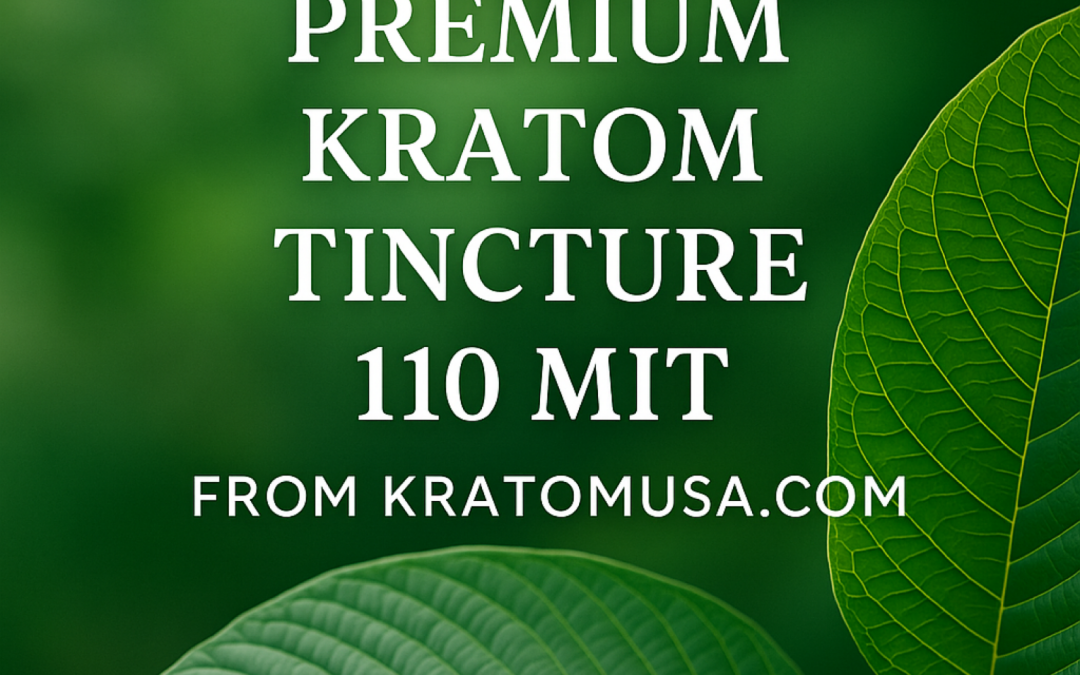
by KratomUSA | Aug 11, 2025 | Kratom
🌱 Explore the Benefits of Kratom USA’s Premium Kratom Tincture 110 MIT

by KratomUSA | Aug 5, 2025 | Kratom
✨ Gold Reserve Kratom Extract: The Premium Blend for Potency and Purity
Discover Kratom USA’s Signature Concentrate Loved by Experienced Users Nationwide
Kratom USA’s Gold Reserve Kratom Extract has built a reputation as one of the most premium kratom concentrates available today. Known for its high alkaloid content, refined extraction process, and trusted sourcing, this blend is crafted for those who seek a next-level kratom experience.
But what exactly is Gold Reserve Extract? Why is it so highly regarded? And how does it compare to other kratom products? This guide breaks it all down so you can decide if it’s right for your routine.
🔑 Key Points
-
Gold Reserve Kratom Extract is a highly concentrated blend of kratom alkaloids and finely ground leaf powder.
-
Sourced and manufactured by Kratom USA, one of the oldest and most reputable vendors in the U.S.
-
May offer a stronger, longer-lasting experience than traditional powders or capsules.
-
Crafted for experienced users seeking a premium product with consistency and reliability.
-
Available for purchase online at KratomUSA.com.
🌿 What Is Gold Reserve Kratom Extract?
Gold Reserve Extract isn’t just a flashy name—it’s a signature blend known for its highly refined concentration. This product combines purified kratom alkaloids (typically from Mitragyna speciosa) with a small amount of high-quality kratom leaf powder to ensure a balanced and smooth delivery.
The result? A powerful extract that offers a unique synergy of alkaloids and plant material.
⚗️ How It’s Made: A Refined Extraction Process
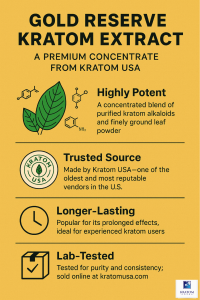 Kratom USA uses a specialized extraction and blending method to isolate and preserve the most active alkaloids—primarily mitragynine and 7-hydroxymitragynine, believed to be responsible for kratom’s effects.
Kratom USA uses a specialized extraction and blending method to isolate and preserve the most active alkaloids—primarily mitragynine and 7-hydroxymitragynine, believed to be responsible for kratom’s effects.
These purified alkaloids are then reintroduced into a base of fine kratom powder. This double-layered approach allows for extended shelf life, easier handling, and a richer user experience.
💥 What Makes Gold Reserve Extract So Popular?
Here’s what makes Gold Reserve stand out in a sea of kratom products:
-
High potency in a small dose
-
Backed by Kratom USA’s two decades of trust
-
Crafted in small batches for quality control
-
Contains no additives or synthetic fillers
-
Ideal for advanced users or occasional high-impact support
👥 What Real Users Say
“Gold Reserve is my go-to when I need a serious boost in focus and mood. I only need a tiny amount to feel it working.”
— James R., Florida
“I’ve tried other extracts, but this one from Kratom USA is by far the smoothest and most reliable.”
— Megan L., Oregon
“Perfect for when regular kratom just doesn’t cut it. Potent, but not overwhelming. Love it!”
— Anthony K., Texas
🔬 What Does the Science Say?
While Gold Reserve is a proprietary product, it is made using well-studied kratom alkaloids:
-
Mitragynine is the most abundant alkaloid and may interact with opioid receptors【Hemby et al., 2019 – Drug and Alcohol Dependence】.
-
7-hydroxymitragynine is more potent by weight and may contribute to more noticeable effects.
-
Concentrated extracts like Gold Reserve are increasingly used by people seeking support for occasional discomfort, mood, or energy—though more formal studies are needed.
⚠️ Always consult your healthcare provider before trying kratom or its extracts.
🧠 Who Should Use Gold Reserve Kratom?
This extract is not intended for beginners due to its strength. Instead, it’s best for:
If you’re newer to kratom, consider starting with a milder powder before graduating to a concentrated extract.
🛒 Where to Buy Gold Reserve Extract
You can purchase Gold Reserve Kratom Extract exclusively at:
👉 https://kratomusa.com/product/gold-reserve-extract/
All products from Kratom USA are:
-
✅ Lab-tested for purity and potency
-
✅ Packaged in GMP-compliant facilities
-
✅ Backed by over 20 years of industry experience
📦 How to Use It
Gold Reserve Extract is typically used in smaller quantities than traditional kratom powder.
-
Start with 1 capsule to assess tolerance.
-
Can be mixed into tea or taken in capsule form.
-
Avoid daily use to prevent tolerance buildup.
❓ FAQ: Gold Reserve Kratom Extract
How strong is Gold Reserve compared to regular kratom?
Gold Reserve is significantly more potent. A little goes a long way, so users should start with a very small dose.
Is Gold Reserve safe?
When used responsibly and purchased from a trusted vendor like Kratom USA, it can be safe for experienced users. Always follow dosage guidelines and avoid mixing with other substances.
Can I use this if I’m new to kratom?
It’s recommended for seasoned users. Beginners should start with traditional powder or capsules.
Is this legal in my state?
Kratom legality varies by location. Check Kratom USA’s shipping policy or your state laws before ordering.
✅ Final Thoughts
If you’re looking for a premium kratom extract that delivers consistent strength, quality sourcing, and trusted results, Gold Reserve Kratom Extract from Kratom USA is a standout choice.
Backed by decades of experience, Kratom USA continues to set the standard in the industry—and their Gold Reserve blend is a testament to that legacy.
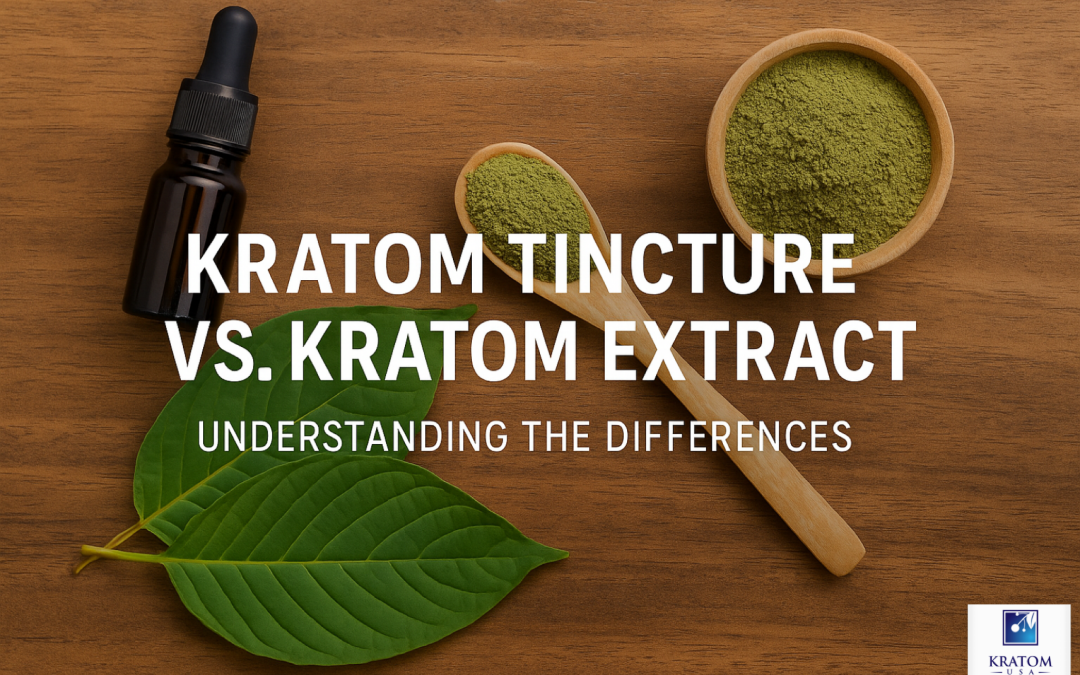
by KratomUSA | Jul 29, 2025 | Kratom
🌿 What’s the Difference and Which One Is Right for You?
Kratom has evolved far beyond its traditional powdered leaf form. Today’s market offers concentrated options like kratom tinctures and kratom extracts, both designed to deliver a more potent experience—but what’s the real difference between kratom tincture versus extract?
Whether you’re curious about how tinctures work, wondering if extracts are stronger, or trying to figure out which is best for your needs, this guide will help you make an informed decision.
🔑 Key Points
-
Kratom tinctures are alcohol-based liquid concentrates made by steeping kratom in ethanol or another solvent.
-
Kratom extracts are highly concentrated powders or resins created by boiling down the plant material.
-
Tinctures are typically easier to measure and dose; extracts are often stronger and more versatile.
-
Both options may provide longer-lasting effects, but potency, onset time, and user experience vary.
-
Always choose products from trusted, lab-tested vendors to ensure safety and consistency.
💧 What Is a Kratom Tincture?
A kratom tincture is a liquid extract created by soaking kratom leaves or powder in a solvent—usually ethanol—over an extended period. This process pulls out the plant’s alkaloids, especially mitragynine and 7-hydroxymitragynine, which are believed to be responsible for many of kratom’s effects.
Pros of kratom tinctures:
-
Easy to dose with a dropper
-
Long shelf life (thanks to alcohol base)
-
Convenient and portable
-
Fast absorption under the tongue (sublingual use)
Cons:
🧪 What Is a Kratom Extract?
Kratom extracts are made by boiling kratom powder or leaves into a concentrated paste, resin, or fine powder. They are typically labeled with ratios like 10x or 50x, meaning the amount of kratom used in the process (though this doesn’t always reflect potency).
Types of extracts:
-
Powdered extracts – looks like regular kratom but much stronger
-
Resin extracts – solid or sticky blocks
-
Liquid extracts – similar to tinctures but may not use alcohol
Pros of kratom extracts:
Cons:
⚖️ Tincture vs. Extract: Side-by-Side Comparison
| Feature |
Kratom Tincture |
Kratom Extract |
| Form |
Liquid |
Powder/Resin/Liquid |
| Potency |
Moderate to High |
High to Very High |
| Absorption Speed |
Fast (sublingual) |
Depends on form |
| Taste |
Bitter (alcohol) |
Bitter or earthy |
| Shelf Life |
Long (alcohol-preserved) |
Varies (depends on form) |
| Ease of Use |
Dropper dosing |
Requires careful measuring |
| Best For |
Discreet use, convenience |
High-potency users |
 💬 What Real Users Say
💬 What Real Users Say
“I love tinctures for on-the-go. A couple drops under the tongue and I’m good for hours without messing with powder.”
— Rachel T., 34
“Kratom extracts give me the relief I need when my regular dose isn’t cutting it. But I have to be careful not to take too much.”
— Marcus B., 42
“Tinctures feel smoother for me than extracts. It’s more subtle but lasts just as long.”
— Eli J., 29
📚 What Do Studies Say?
While formal research on tinctures and extracts is limited, we do know that:
-
Mitragynine and 7-hydroxymitragynine are the primary alkaloids responsible for kratom’s psychoactive effects.
-
The concentration and absorption of these alkaloids can vary greatly depending on the preparation method.
-
Anecdotal reports from surveys (like the 2020 Johns Hopkins kratom study) show that users often turn to concentrated forms for stronger, longer-lasting effects.
🧠 Who Should Use Which?
💧 Use a tincture if you:
-
Prefer discreet or on-the-go options
-
Want easy, accurate dosing
-
Are new to concentrated kratom products
🧪 Use an extract if you:
🛒 Tips for Choosing Quality Products
-
✅ Look for lab-tested products
-
✅ Check for alkaloid concentration on the label
-
✅ Avoid anything that doesn’t disclose ingredients or source
-
✅ Purchase from reputable vendors with consistent reviews
❓ FAQ: Kratom Tincture vs. Extract
What’s stronger—kratom tincture or extract?
Extracts are generally more potent by volume, but tinctures may absorb faster when used sublingually.
Are tinctures safer than extracts?
Tinctures are easier to dose precisely, making them a better starting point for beginners.
Can I use both tinctures and extracts?
Yes, but alternating use can help prevent building up a tolerance too quickly.
Do kratom tinctures contain alcohol?
Most do, but some vendors offer glycerin-based or alcohol-free tinctures.
Are these products legal?
Kratom’s legality varies by state and country. Check local laws before purchasing.
✅ Final Thoughts
Both kratom tinctures and kratom extracts offer unique benefits depending on your preferences and experience level. Tinctures are discreet, convenient, and ideal for controlled dosing. Extracts offer powerful effects, but should be approached with caution and respect.
Whether you’re new to concentrated kratom or looking to upgrade your experience, the key is to choose high-quality products from trusted vendors—and always start low, go slow.

 Organic kratom is the dried, ground leaf of the Mitragyna speciosa tree, which grows in Southeast Asia. Traditionally brewed into tea or chewed for energy and focus, kratom leaves contain dozens of naturally occurring alkaloids, such as mitragynine and 7-hydroxymitragynine, that work synergistically to provide balanced effects.
Organic kratom is the dried, ground leaf of the Mitragyna speciosa tree, which grows in Southeast Asia. Traditionally brewed into tea or chewed for energy and focus, kratom leaves contain dozens of naturally occurring alkaloids, such as mitragynine and 7-hydroxymitragynine, that work synergistically to provide balanced effects.


 7‑Hydroxymitragynine (often shortened to 7‑OH) is a minor yet highly potent alkaloid found naturally in the leaves of the Mitragyna speciosa tree, commonly known as kratom. It is present in trace amounts, usually under 0.05% of the leaf’s alkaloid content.
7‑Hydroxymitragynine (often shortened to 7‑OH) is a minor yet highly potent alkaloid found naturally in the leaves of the Mitragyna speciosa tree, commonly known as kratom. It is present in trace amounts, usually under 0.05% of the leaf’s alkaloid content.
 While 7-hydroxymitragynine (7-OH) is a highly potent alkaloid in kratom, many experts and users advocate for using full-spectrum kratom products instead of isolated compounds. Full-spectrum kratom contains a diverse profile of alkaloids—including mitragynine, speciociliatine, paynantheine, and others—that work synergistically to create what is often referred to as the “entourage effect.”
While 7-hydroxymitragynine (7-OH) is a highly potent alkaloid in kratom, many experts and users advocate for using full-spectrum kratom products instead of isolated compounds. Full-spectrum kratom contains a diverse profile of alkaloids—including mitragynine, speciociliatine, paynantheine, and others—that work synergistically to create what is often referred to as the “entourage effect.”
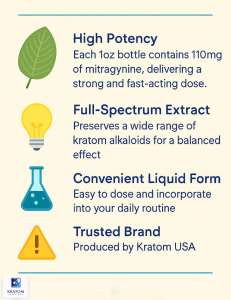 Premium Kratom Tincture 110 MIT is a liquid extract derived from high-quality kratom leaves.
Premium Kratom Tincture 110 MIT is a liquid extract derived from high-quality kratom leaves.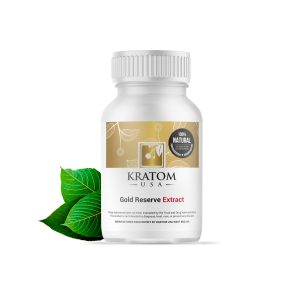


 Kratom USA uses a specialized extraction and blending method to isolate and preserve the most active
Kratom USA uses a specialized extraction and blending method to isolate and preserve the most active 
 💬 What Real Users Say
💬 What Real Users Say